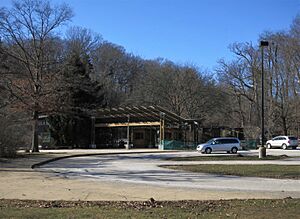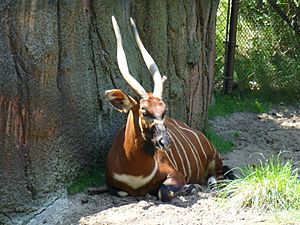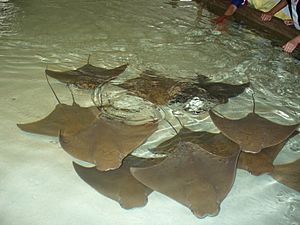John Ball Zoological Garden facts for kids
 |
|
| Date opened | 1891 |
|---|---|
| Location | Grand Rapids, Michigan, U.S. |
| Land area | 140 acres (57 ha) |
| Coordinates | 42°57′46.02″N 85°42′17.24″W / 42.9627833°N 85.7047889°W |
| No. of animals | 2000+ |
| No. of species | 238 |
| Memberships | Association of Zoos and Aquariums |
The John Ball Zoo is a fun place located on the west side of Grand Rapids, Michigan, in the United States. It sits on hills and bluffs, making it a unique home for animals.
This zoo is a major attraction in the area. It is home to over 2,000 animals from more than 200 different species! The John Ball Zoo also helps the community and the world through its Zoo School and Wildlife Conservation Fund. It is a special place that teaches people about animals and works to protect them. The zoo is also a member of the Association of Zoos and Aquariums, and it was the first zoo in Michigan to get this important approval.
Contents
History of the Zoo
How the Zoo Started
The land for the zoo, about 40 acres, was given to the city by a famous explorer named John Ball when he passed away in 1884. Soon after, another 100 acres were added. This new land allowed for many cool things to be built, like ponds, a theater, playgrounds, and trails. The zoo officially started in 1891. Records show that people debated if city money should be used to buy more animals. At that time, the zoo mostly had wounded or orphaned animals.
During the Great Depression, a tough time in history, the zoo faced many challenges. Most of its animals were sent to other zoos. Sadly, some animals like buffalo and deer were used to feed people who were struggling. Only a few old animals remained at the zoo.
The Zoo's Comeback
In 1949, a woman named Katherine Whinery had an idea to bring the zoo back to life. She talked to the mayor of Grand Rapids about starting a zoo society. They made a deal: if a zoo society was formed, the city would hire someone to run the zoo. Fred Meyer became the first director.
The first big new exhibit, Monkey Island, began construction in 1949 and opened on June 1, 1950. Throughout the 1950s and 1960s, the John Ball Zoo grew and developed more exhibits in the hilly parts of its property.
Recent Changes and Growth

The City of Grand Rapids managed the John Ball Zoo until 1989. Because the zoo was so important to the region, it was then sold to Kent County.
In the 1990s, the zoo added exciting new areas. The Living Shores Aquarium was built, which is one of only two aquariums in Michigan. A new cafe was also added nearby. At the same time, a new home for bald eagles was created. In 2001, the Mokomboso Valley Chimpanzee Exhibit opened, giving the chimps a great new space.
From 2000 to 2003, there was a discussion about moving the zoo to a flatter part of the property to build a new elephant exhibit. This idea caused some disagreement between the zoo and its neighbors. To help solve the problem, Fred Meijer offered to donate land and money if the zoo would move. However, in 2004, the people of Kent County voted against moving the zoo. So, the John Ball Zoo stayed in its original location.

In 2005, a big plan was made for the zoo's future, covering all 140 acres. This plan aimed to improve the entire zoo, adding to existing exhibits like the camels, African veld, chimps, petting zoo, and animal hospital. The new plan also included a system of streams called "Grand Rivers of the World" to connect different parts of the zoo.
On April 27, 2007, construction began on the "BISSELL Lions of Lake Manyara" exhibit. This $4.1 million project was built for six African lions. The zoo had not had a lion since "Gilda" passed away in 2005. The new, environmentally friendly lion exhibit opened to the public on June 21, 2008.

In 2008-2009, Kent County helped pay for half of the cost to update the Monkey Island Exhibit. The spider monkeys enjoyed their newly renovated island in May 2009. The old concrete wall around the exhibit was removed, and the cement floor was replaced with grass and natural-looking rocks.
In 2014, the zoo created a non-profit organization to take over its ownership from Kent County. This change helps the zoo grow and develop even more.
On July 8, 2016, the stingray lagoon exhibit had to close. All 18 cownose stingrays and three spotted bamboo sharks died because of a mechanical problem. A heavy rainstorm caused a pump circuit to short out, and the backup system that should have alerted zoo staff also failed.
Inclined Railway Ride
In August 2012, a special inclined railway opened at the zoo. This train has three cars linked together and takes visitors on a four-minute ride to the higher areas of the park. It's a unique way to see the zoo!
Animal Collection
The John Ball Zoo is home to many different animals. Most of the animals at the zoo were born in other zoos. Very few are taken from the wild. Almost all wild animals at the zoo are there because they were injured and cannot live safely in their natural homes anymore.
| Species | Individuals |
|---|---|
| 43 mammals | 149 |
| 58 birds | 219 |
| 41 reptiles | 79 |
| 11 amphibians | 26 |
| 35 fish | 318 |
| 48 invertebrates | 391 |
| 236 total species | 1182 total animals |
In 2004, the zoo welcomed a Komodo dragon named Precious. Precious lived a long life and passed away in December 2014.
In 2005, the zoo opened an exciting Australian walk-through exhibit. Here, visitors can see wallabies and budgies. If the wallabies choose to, they can even come out into the walkway for visitors to pet them!
On May 9, 2007, the river otters had a baby boy, who started exploring the exhibit in mid-July. In early September of that year, the female black-footed cat had two adorable kittens.
The ring-tailed lemur exhibit was started in March 2009 and the lemurs were out for visitors to see in May.
In 2010, the zoo welcomed a group of Guinea baboons. They also brought in the largest alligator outside of Florida. The zoo moved its flamingos to a different pond and changed the old tiger exhibit to house a rock hyrax and a group of colobus monkeys.
In 2021, the John Ball Zoo announced a new habitat for pygmy hippos at the zoo's entrance. This exhibit, which also houses a pair of white storks, opened in 2023. In 2022, the John Ball Zoo hosted two male koalas from the San Diego Zoo Global Education and Conservation Project. Their exhibit opened on May 11, 2022.
The zoo also offers special "Close Encounters" that guests can book for an extra fee. These experiences allow visitors to get up close with animals like a red panda, feed a hippo, or interact with a sloth.
- Mammals
- African lion
- Amur tiger
- Black-headed spider monkey
- Black howler monkey
- Cape porcupine
- Canada lynx
- Capybara
- Chimpanzee
- Cotton-top tamarin
- Cougar
- Dromedary camel
- Eastern bongo
- Geoffroy's spider monkey
- Giant anteater
- Goeldi's monkey
- Grizzly bear
- Meerkat
- North American porcupine
- North American river otter
- Pygmy hippopotamus
- Red-necked wallaby
- Red panda
- Ring-tailed lemur
- Six-banded armadillo
- Snow leopard
- Warthog
- White-faced saki monkey
- White-nosed coati
- Birds
- African grey parrot
- Bald eagle
- Barn owl
- Black swan
- Budgerigar
- Chilean flamingo
- Crested screamer
- Common barn owl
- Egyptian goose
- Golden eagle
- Great horned owl
- Kelp gull
- Magellanic penguin
- Pied crow
- Snowy owl
- Southern ground hornbill
- Sulphur-crested cockatoo
- Toco toucan
- Von der Decken's hornbill
- White stork
- Reptiles
- Baron's racer
- Boa constrictor
- Carrot-tail viper gecko
- Chinese crocodile lizard
- Chuckwalla
- Cuvier's dwarf caiman
- Green keel-bellied lizard
- Geyr’s spiny-tailed lizard
- Gila monster
- Grand Cayman blue iguana
- Green anaconda
- Green tree python
- Madagascar giant day gecko
- Northern water snake
- Reticulated python
- Tiger ratsnake
- Western diamond back
- Amphibians
- Emperor newt
- Chacoan horned frog
- Dyeing poison dart frog
- Golden poison dart frog
- Grey tree frog
- Kaup's caecilian
- Magnificent tree frog
- Mantella frog
- Panamanian golden frog
- Poison dart frog
- Red-eyed tree frog
- Reed frog
- Sambava tomato frog
- Vietnamese mossy frog
- Fish
- Invertebrates
- Brazilian salmon tarantula
- Giant cave cockroach
- Giant Japanese spider crab
- Sea anemone
- Sea star
- Sea urchin
- Spiny lobster
Education and Conservation Efforts
Zoo School Programs
The John Ball Zoo School is a special magnet school for sixth graders in the Grand Rapids Public Schools. Each year, sixty students are chosen to attend this school. They learn the regular school subjects, but they use the zoo as their classroom! Students get to visit the zoo often and even have limited access inside some animal enclosures for hands-on learning. They also work on big projects, like studying current events and environmental issues.
Wildlife Conservation Fund
In 1985, a special fund was started by John Boyles to help protect wildlife. This fund focuses on animals native to Michigan, but it also supports programs for endangered amphibians and reptiles around the world. The Wildlife Conservation Fund has helped protect animals and their homes in 30 different countries!
See Also
- List of funicular railways


